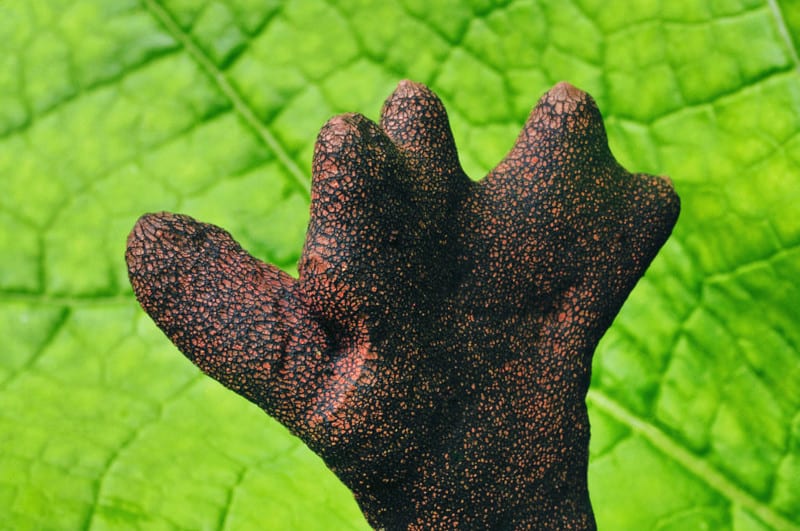
Dead Man’s Fingers Facts
- The attention-grabbing term of Dead Man’s Fingers perfectly fits this extremely distinctive fungus. That’s partly due to the fact that it evolved as a saprobic variety, meaning that it thrives among decaying organic matter. Xylaria polymorpha serves as its scientific name.
- The first recorded scientific recognition of this remarkable species occurred in the year 1797. A renowned German mycologist originally registered that acknowledgement under a different name, though. At that time, he initially named the amazing fungus Sphaeria polymorpha.
- While some forms of fungi can be safely consumed, that does not hold true for this particular variety. Although not toxic in any way, or technically inedible, very few people attempt to eat them. That’s largely due to the fact that the outer covering has a hard, wood-like texture.
- Fortunately for this particular member of its Class, its population appears to be both stable and sufficient. It’s also reasonably wide spread in terms of its habitat range. The IUCN therefore currently has no listing for it on the organization’s published Red List of Threatened Species.
- The visually remarkable Dead Man’s Fingers nonetheless does face certain threats to its continued existence as a species, like most forms of life. Given that it thrives most commonly in forests, deforestation naturally poses a great threat. Climate change also threatens it.
Related Articles
Dead Man’s Fingers Physical Description
It must also be pointed out that the intriguing Dead Man’s Fingers tantalizes us with its appearance wholly without relying on sheer physical size. That’s due to the simple fact that it’s not a very large species. In terms of sheer dimensions, it represents a roughly average-sized type of fungus.
It doesn’t grab one’s attention due to its vertical reach. That’s because individual specimens only average between approximately 1.2 – 3.1 in (3 – 8 cm) in height. Meanwhile, it develops a notably club-shaped form. This feature of the wonder also develops as thicker at the base than the top.
This wonder of Nature and evolution does hold an intriguing characteristic, though. Each specimen varies in terms of its stalk. Some possess a single one of these structures, while others produce multiples. Regardless of the number, however, these average 0.4 – 1.2 in (1 – 3 cm) in diameter.
Initially, the outer surface of the fascinating Dead Man’s Fingers appears as either a grayish or white in color. As examples develop, however, this changes to black, with tinges of blue or green. It also develops a covering of a fine powder, that becomes more granulated as the specimen matures.
The most immediately noticeable physical characteristic of the awesome species, though, remains the one that serves as the source of its distiinctive common name. That’s because, when a specimen does develop multiple stalks, these generally bear a very strong resemblance to a skeletal hand.
- Kingdom: Fungi
- Phylum: Ascomycota
- Class: Sordariomycetes
- Order: Xylariales
- Family: Xylariaceae
- Genus: Xylaria
- Species: X. polymorpha
Dead Man’s Fingers Distribution, Habitat, and Ecology
Interestingly, the impressive Dead Man’s Fingers evolved as indigenous to a unique area. That actually consists of a relatively large portion of the surface of the earth. Yet, despite this fact, its native zone of habitation appears to be simultaneously surprisingly broad, yet markedly broken.
In one region, this marvel of biological processes developed as native to much of mainland Europe. There, though, the species resides across a large section of the landmass, it typically does so in widely scattered concentrations. For now, it’s most prevalent in the countries of Ireland and Britain.
However, the intrepid fungus also appears in yet another part of the world. More precisely, it additionally grows in many regions of North America. On that continent, most of its population appears in the United States. Accidental importation by man is the most likely cause of its presence.
Wherever this visually distinctive species appears, though, like most fungi, it displays decided preferences regarding its choice of where to reside. To be more precise, populations of the startling Dead Man’s Fingers rarely appear outside of deciduous forests. That’s due to its basic nature.
Being saprobic in that respect, it almost always appears either on or in proximity to the remains of dead trees. Even more specifically, however, these almost always consist of dead beech trees. On the rare occasions that it’s spotted on other species, these always consist of other broadleaf types.
This unique fungus actually plays a vital role within the various local ecosystems it appears in. It consumes the compounds that bind the fibers of the wood together. As a result, the countless numbers of local insect species are able to feast on the rest of the remains of the tree more readily.
Species Sharing Its Range
Bald Eagle
Check out our other articles on 5 Geological Marvels of Arizona, Tufted coquette, Christmas Island, Hawaiian Monk Seal, Salt Creek Tiger Beetle, Purple Frog, Tiger Shark, Jackson’s Chameleon
